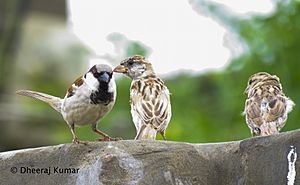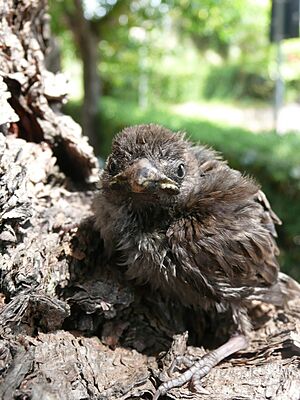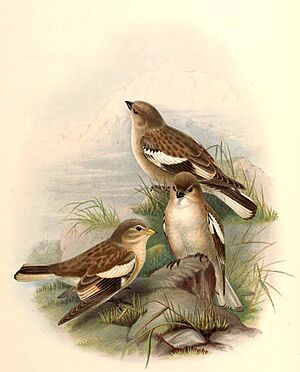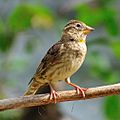Old World sparrow facts for kids
Quick facts for kids Old World sparrow |
|
|---|---|
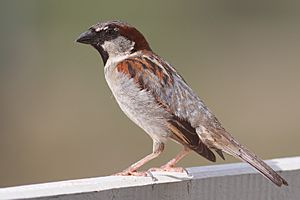 |
|
| Male house sparrow (Passer domesticus) | |
| Scientific classification |
|
| Kingdom: | Animalia |
| Phylum: | Chordata |
| Class: | Aves |
| Order: | Passeriformes |
| Suborder: | Passeri |
| Infraorder: | Passerida |
| Superfamily: | Passeroidea |
| Family: | Passeridae Rafinesque, 1815 |
| Type genus | |
| Passer Brisson, 1760
|
|
| Genera | |
|
|
Old World sparrows are a group of small birds. They belong to a family called Passeridae. People also call them true sparrows. This name is also used for a specific group of sparrows, the Passer genus.
These sparrows are different from New World sparrows. New World sparrows belong to a different family called Passerellidae. Old World sparrows are also not the same as other birds that share the name "sparrow," like the Java sparrow.
Many kinds of Old World sparrows build their nests on buildings. The house and Eurasian tree sparrows, for example, live in cities in large numbers. This makes sparrows some of the most common wild birds we see. They mostly eat seeds, but they also munch on small insects. Some sparrows living in cities will eat almost anything they find, just like gulls or rock doves.
Contents
What Do Sparrows Look Like?
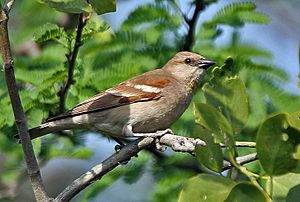
Generally, Old World sparrows are small, round, brown, and grey birds. They have short tails and strong, thick beaks. The differences between different types of sparrows can be hard to spot.
Sparrows in this family range in size. The chestnut sparrow is about 11.4 centimeters (4.5 inches) long and weighs about 13.4 grams (0.47 ounces). The parrot-billed sparrow is larger, about 18 centimeters (7.1 inches) long and weighing 42 grams (1.5 ounces).
Sparrows look a lot like other birds that eat seeds, such as finches. However, sparrows have a tiny extra bone in their tongue. This bone helps make their tongue stiff when they hold seeds. They also have special beaks and digestive systems that help them eat seeds.
Sparrow Families and Groups
The family Passeridae was first named by a French scientist, Constantine Samuel Rafinesque, in 1815. In this family, there are main groups of sparrows. These include the true sparrows (genus Passer), the snowfinches (genus Montifringilla), and the rock sparrows (genus Petronia). These groups are quite similar to each other.
Some scientists used to group Old World sparrows with other bird families. For example, they were sometimes placed with weavers or finches. This was because they had similar ways of building nests, similar beaks, and similar ways of changing their feathers.
It's important to know that New World sparrows are not in the same family. They are in the Passerellidae family. Also, the hedge sparrow is not a true sparrow. It's just called a sparrow because many small birds used to be called "sparrows" a long time ago. The Java sparrow is also not a true sparrow; it's a type of finch.
The Passeridae family has 43 different species of sparrows. These species are divided into eight main groups, called genera.
Where Do Sparrows Live?
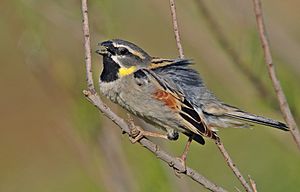
Old World sparrows originally came from Europe, Africa, and Asia. But people brought some species to the Americas, Australia, and other parts of the world. These sparrows quickly made themselves at home, especially in cities and disturbed areas.
For example, house sparrows are now found all over North America and Australia. They are also in parts of southern and eastern Africa, and many populated areas of South America.
Old World sparrows usually live in open areas. These include grasslands, deserts, and scrubland. The snowfinches and ground-sparrows live in very cold, high places. Some sparrows, like the Eurasian tree sparrow, live in open woodland. The cinnamon ibon is special. It lives in the tops of trees in cloud forests in the Philippines.
How Sparrows Live and Behave
Old World sparrows are usually social birds. Many species nest together in groups. Most species also gather in large flocks when it's not breeding season. The great sparrow is different. It nests alone and stays in small family groups when not breeding.
Sparrows form large groups to sleep in during the non-breeding seasons. These groups usually have only one type of sparrow. They choose places with good cover, like trees, thick bushes, or reed beds. These groups can be very big. For example, up to 10,000 house sparrows have been counted sleeping together in Egypt.
-
Sudan golden sparrows, seen here on the Red Sea coast of Sudan, are very social when they are not breeding.
Old World sparrows are some of the few small birds that take dust baths. They first dig a hole in the ground with their feet. Then, they lie in it and throw dirt or sand over their bodies using their wings. They also bathe in water or in dry or melting snow. Water bathing is similar to dust bathing. The sparrow stands in shallow water and flicks water over its back with its wings. It also dips its head under the water. Both dust and water bathing are social activities. Up to a hundred birds might join in at once. After bathing, they clean their feathers and sometimes sing together.
Sparrows and People
Old World sparrows might be the most well-known wild birds in the world. Many species often live in farming areas. For some, human towns and cities are their main home. The Eurasian tree and house sparrows are especially good at living near people. They live in cities in huge numbers. Out of 26 known species, 17 are known to nest on and find food around buildings.
Sparrows that eat grain, especially the house and Sudan golden sparrows, can sometimes be a problem for farmers. They are seen as pests because they eat crops. However, they can also help humans by eating insect pests. In the 1950s, China tried to get rid of sparrows in a big campaign. But this led to a huge increase in insect attacks, probably because there were fewer sparrows to eat them.
Because they are so common, house sparrows and other sparrows are often used to represent everyday things. Sparrows are mentioned in many old stories and religious texts from Europe and western Asia. These stories might not always be about true sparrows, but later writers often thought of house sparrows when they read them.
For example, the ancient Greeks linked Old World sparrows with Aphrodite, the goddess of love. This was because they seemed very lively. Writers like Chaucer and Shakespeare later used this idea too.
In the Gospel of Matthew, Jesus uses "sparrows" as an example of God's care. This inspired later references, like in Shakespeare's play Hamlet and the Gospel hymn "His Eye Is on the Sparrow".
Sparrows are rarely seen in ancient Egyptian art. However, an Egyptian hieroglyph
|
|
is based on the house sparrow. This symbol didn't have a sound. It was used in words to show something was small, narrow, or bad.
People have kept Old World sparrows as pets throughout history. Even though they are not very colorful and their songs are not special, some people enjoy them. They can be hard to care for because baby sparrows need to be fed by hand with many insects. Still, many people successfully raise orphaned or abandoned baby sparrows.
The earliest stories about pet sparrows come from the Romans. Not all the "passeri" mentioned in Roman writings were definitely sparrows. But some descriptions clearly match their look and habits. The pet "passer" in Catullus's poems might not have been a sparrow, but a thrush or European goldfinch. A poem by John Skelton called The Boke of Phyllyp Sparowe is a sad poem about a pet house sparrow that belonged to a girl named Jane Scrope.
Images for kids
See also
 In Spanish: Paséridos para niños
In Spanish: Paséridos para niños



